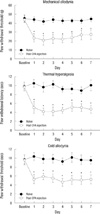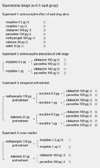1. Wang GK, Mitchell J, Wang SY. Block of persistent late Na+ currents by antidepressant sertraline and paroxetine. J Membr Biol. 2008. 222:79–90.
2. Coquoz D, Porchet C, Dayer P. Central analgesic effects of desipramine, fluvoxamine, and moclobemide after single oral dosing: a study in healthy volunteers. Clin Pharmacol Ther. 1993. 54:339–344.
3. Korzeniewska-Rybicka I, Płaźnik A. Analgesic effect of antidepressant drugs. Pharmacol Biochem Behav. 1998. 59:331–338.
4. Finley PR. Selective serotonin reuptake inhibitors: pharmacologic profiles and potential therapeutic distinctions. Ann Pharmacother. 1994. 28:1359–1369.
5. Cookson J. Side-effects of antidepressants. Br J Psychiatry Suppl. 1993. 20–24.
6. Richelson E, Pfenning M. Blockade by antidepressants and related compounds of biogenic amine uptake into rat brain synaptosomes: most antidepressants selectively block norepinephrine uptake. Eur J Pharmacol. 1984. 104:277–286.
7. Martin WJ, Gupta NK, Loo CM, Rohde DS, Basbaum AI. Differential effects of neurotoxic destruction of descending noradrenergic pathways on acute and persistent nociceptive processing. Pain. 1999. 80:57–65.
8. Millan MJ. Descending control of pain. Prog Neurobiol. 2002. 66:355–474.
9. Yoshimura M, Furue H. Mechanisms for the anti-nociceptive actions of the descending noradrenergic and serotonergic systems in the spinal cord. J Pharmacol Sci. 2006. 101:107–117.
10. Beaudry H, Proteau-Gagné A, Li S, Dory Y, Chavkin C, Gendron L. Differential noxious and motor tolerance of chronic delta opioid receptor agonists in rodents. Neuroscience. 2009. 161:381–391.
11. Kwon MY, Jun IG, Kim TH, Park JY. The interaction of morphine and selective serotonin reuptake inhibitors on mechanical allodynia in rats with a spinal nerve ligation. Korean J Anesthesiol. 2008. 55:87–94.
12. Xu JJ, Walla BC, Diaz MF, Fuller GN, Gutstein HB. Intermittent lumbar puncture in rats: a novel method for the experimental study of opioid tolerance. Anesth Analg. 2006. 103:714–720.
13. Hargreaves K, Dubner R, Brown F, Flores C, Joris J. A new and sensitive method for measuring thermal nociception in cutaneous hyperalgesia. Pain. 1988. 32:77–88.
14. Lynch JJ III, Wade CL, Zhong CM, Mikusa JP, Honore P. Attenuation of mechanical allodynia by clinically utilized drugs in a rat chemotherapy-induced neuropathic pain model. Pain. 2004. 110:56–63.
15. Otsuka N, Kiuchi Y, Yokogawa F, Masuda Y, Oguchi K, Hosoyamada A. Antinociceptive efficacy of antidepressants: assessment of five antidepressants and four monoamine receptors in rats. J Anesth. 2001. 15:154–158.
16. Pettersen VL, Zapata-Sudo G, Raimundo JM, Trachez MM, Sudo RT. The synergistic interaction between morphine and maprotiline after intrathecal injection in rats. Anesth Analg. 2009. 109:1312–1317.
17. Max MB, Lynch SA, Muir J, Shoaf SE, Smoller B, Dubner R. Effects of desipramine, amitriptyline, and fluoxetine on pain in diabetic neuropathy. N Engl J Med. 1992. 326:1250–1256.
18. Jackson KC 2nd. Pharmacotherapy for neuropathic pain. Pain Pract. 2006. 6:27–33.
19. Bourin M, Chue P, Guillon Y. Paroxetine: a review. CNS Drug Rev. 2001. 7:25–47.
20. Richelson E. Pharmacology of antidepressants. Mayo Clin Proc. 2001. 76:511–527.
21. Jung AC, Staiger T, Sullivan M. The efficacy of selective serotonin reuptake inhibitors for the management of chronic pain. J Gen Intern Med. 1997. 12:384–389.
22. Obata H, Saito S, Koizuka S, Nishikawa K, Goto F. The monoamine-mediated antiallodynic effects of intrathecally administered milnacipran, a serotonin noradrenaline reuptake inhibitor, in a rat model of neuropathic pain. Anesth Analg. 2005. 100:1406–1410.
23. Nagata K, Imai T, Yamashita T, Tsuda M, Tozaki-Saitoh H, Inoue K. Antidepressants inhibit P2X4 receptor function: a possible involvement in neuropathic pain relief. Mol Pain. 2009. 5:20.
24. Sindrup SH, Gram LF, Brøsen K, Eshøj O, Mogensen EF. The selective serotonin reuptake inhibitor paroxetine is effective in the treatment of diabetic neuropathy symptoms. Pain. 1990. 42:135–144.
25. Ikeda T, Ishida Y, Naono R, Takeda R, Abe H, Nakamura T, Nishimori T. Effects of intrathecal administration of newer antidepressants on mechanical allodynia in rat models of neuropathic pain. Neurosci Res. 2009. 63:42–46.
26. Gray AM, Spencer PS, Sewell RD. The involvement of the opioidergic system in the antinociceptive mechanism of action of antidepressant compounds. Br J Pharmacol. 1998. 124:669–674.
27. Sawynok J, Liu XJ. Adenosine in the spinal cord and periphery: release and regulation of pain. Prog Neurobiol. 2003. 69:313–340.
28. Lavand'homme PM, Eisenach JC. Exogenous and endogenous adenosine enhance the spinal antiallodynic effects of morphine in a rat model of neuropathic pain. Pain. 1999. 80:31–36.
29. Hwang JH, Hwang GS, Cho SK, Han SM. Morphine can enhance the antiallodynic effect of intrathecal R-PIA in rats with nerve ligation injury. Anesth Analg. 2005. 100:461–468.
30. Ossipov MH, Lai J, Malan TP Jr, Porreca F. Spinal and supraspinal mechanisms of neuropathic pain. Ann N Y Acad Sci. 2000. 909:12–24.
31. King T, Rao S, Vanderah T, Chen Q, Vardanyan A, Porreca F. Differential blockade of nerve injury-induced shift in weight bearing and thermal and tactile hypersensitivity by milnacipran. J Pain. 2006. 7:513–520.








 PDF
PDF ePub
ePub Citation
Citation Print
Print



 XML Download
XML Download